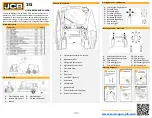
44
SPECIAL ADJUSTMENTS
4-13 ADJUSTMENT OF DRILL SENSORS - LOCK DRILL
Under normal operating conditions the lock drill will remain properly adjusted for depth of cut. How
-
ever, should the need arise for adjustment, the sensors on the cylinder will need to be moved. As shown
in figure 4.6 below there are three sensors. The home sensor indicates that the lock drill has returned to
its resting position. If it is not triggered the drill cycle will not start. The door pull sensor is used when the
operator wants a pocket ,not a full bore, through the door. This may need adjustment if the depth of cut
needs to be changed. The lock bore limit sensor may need adjustment if the cutter is not cutting com
-
pletely through the door. To adjust these sensors all that is needed is a flat blade screwdriver. First loosen
the machine screw then move the sensor along the cylinder as needed. Tighten down the screw when
done.
FIGURE 4-6
HOME SENSOR
LOCK BORE LIMIT SENSOR
DOOR PULL SENSOR
Under normal operating conditions the latch drill will remain properly adjusted for depth of cut. Howev
-
er, should the need arise for adjustment, the sensors on the cylinder will need to be moved as was the case
with the lock drill. As shown in figure 4.7 (next page) there are three sensors. The home sensor indicates
that the latch drill has returned to its resting position. If it is not triggered the drill cycle will not start. The
short stroke sensor is used for certain backsets. This may need adjustment if the depth of cut needs to be
changed. The lock bore limit sensor may need adjustment if the cutter is not cutting completely through
the lock bore. To adjust these sensors all that is needed is a flat blade screwdriver. First loosen the ma
-
chine screw then move the sensor along the cylinder as needed. Tighten down the screw when done.
4-14 ADJUSTMENT OF DRILL SENSORS - LATCH DRILL





































